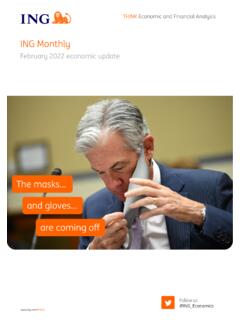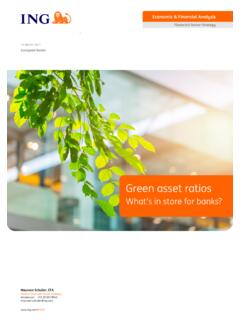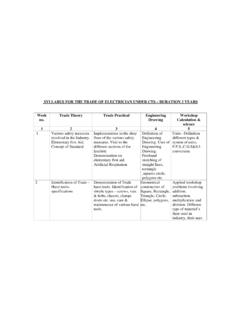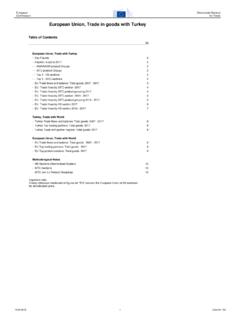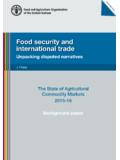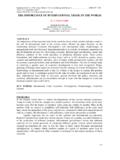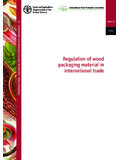Transcription of Trade impacts of the Belt and Road Initiative
1 Trade impacts of the Belt and Road Initiative June 2018 1 Trade impacts of the Belt and Road Initiative The major global Trade boost which could come from significant cost reductions, and what might get in the way The Belt and Road Initiative (BRI) is increasing transport connections between Asia and Europe with potential consequences for international Trade . Trade between the countries involved accounts for more than a quarter of world Trade , so better connections and the lower Trade costs that come with them could have a significant global impact. A halving in Trade costs between countries involved in the BRI could increase world Trade by 12%. Countries in Eastern Europe and Central Asia stand to benefit most, but the benefits will depend on where Trade costs fall. There are already some opportunities to transport goods via rail between China and Europe, which may appeal to the wide range of industries with time-sensitive inputs and products.
2 It could take many years before other impacts of the BRI are seen. Many projects are under construction, and the BRI is open-ended. Trade facilitation barriers between countries also need to be addressed. Belt and Road President Xi Jinping launched the Belt and Road Initiative in 2013 (at the time, it was known as the One Belt One Road Initiative ). China has highlighted five different priorities for the BRI: policy co-ordination, unimpeded Trade , facilitating connectivity, financial integration, and bonds between peoples (Source: China National Development and Reform Commission (2015)). The BRI is often also discussed as a policy for rebalancing the Chinese economy, stimulating Western regions, and advancing its strategic and geopolitical goals. This report focuses on the BRI as a large and long-term programme of investment in transport infrastructure across Asia and Europe.
3 It looks at the infrastructure being built and how Trade in goods could change as a result, setting other aspects of the BRI (and Trade in services) to one side. The Belt and Road refer to the overland and maritime Trade routes between China, Europe, the Middle East, and East Africa. The BRI will see these routes renewed and improved through a number of large-scale infrastructure projects. Along the Belt, roads, rail links, dry ports and industrial zones are being developed. Along the Road, sea ports and their connections to overland Trade routes are being modernised (Figure 1). Joanna Konings Senior Economist, International Trade Analysis Amsterdam +31 20 576 4366 Trade Economic & Financial Analysis 6 June 2018 Global Economics Transport infrastructure projects across Asia and Europe are a key part of the Belt and Road Initiative Trade impacts of the Belt and Road Initiative June 2018 2 Fig 1 The Belt consists of overland economic corridors while ports along the Road are gateways to and from international shipping routes Source: ING Progress and challenges China-led development of transport infrastructure in Asia is not new.
4 In the decade before the BRI was launched, China built pipelines to link its natural gas supply to pipelines in Central Asia and Russia, developed its own national integrated transport system, and connected its railways with networks in South East Asia. Block train services began to run between China (Chongqing) and Germany (Duisberg) in 2011. However, the majority of projects identified with the BRI so far are still in their construction phases with completion dates in the coming five The BRI is open-ended, so more projects are likely to be initiated during that time. International rail services between China and Europe did not begin with the BRI, but have increased since its announcement. New services have started running between Yiwu, Hefei and Harbin major inland cities in Central and Eastern China - and Madrid and Hamburg.
5 Rail freight has increasingly been transported between China and Europe via Kazakhstan, benefiting from infrastructure in the northern parts of the Trans-Asian rail network that pre-dated the Other parts of the Trans-Asian rail network do not yet support international freight services to the same degree. Gaps in the network require around 12,400km of track to be laid (some 10% of the network).3 Routes through Iran and Turkey (designated as the BRI s China-Central Asia-West Asia economic corridor ) could offer an alternative route between China and Europe, as well as connecting China, the Middle East and North Africa by rail. However, this will only be feasible with more investment to construct and upgrade the network and its supporting infrastructure. The majority of goods traded between China and the EU are transported by ship through the Suez Canal.
6 The Road element of the BRI involves China through its liner and terminal operator Cosco developing a portfolio of ports with highly efficient terminal operations (loading and unloading container ships) and connections to overland transport networks. Ports along the Road may increasingly function as gateways inland rather than just handling the transhipment of containers to be unloaded elsewhere. Key ports along the Road are Piraeus (Greece), as an access point to and from the EU, and Gwadar (Pakistan), as a link between the Belt and the Road. 1 Barisitz and Radyner (2017a, 2017b) provide a project-based stocktake of the BRI s progress. Steer Davies Gleave (2018) include a list of Chinese transport and infrastructure projects in other BRI countries. 2 Pomfret (2018). 3 UNESCAP (2017).
7 Rail services are running between new destinations in China and Europe China aims to create a portfolio of efficient and well-connected ports Trade impacts of the Belt and Road Initiative June 2018 3 Cosco acquired a majority share of Piraeus port in 2016 and is investing in the port s capacity and operations. China envisions the creation of a European Land-Sea Express Route by constructing rail connections from Piraeus through Eastern Europe. Gwadar port has been operating since 2007, but BRI projects are expanding the port to enable it to handle different types of goods and larger container ships. Other BRI projects are connecting the port to the Trans-Asian rail network. Once complete, the port and onward connections at Gwadar could provide a route for oil imports into China from the Middle East. For landlocked Central Asian countries, they offer a connection to shipping routes.
8 Apart from infrastructure, Trade facilitation is a barrier to Trade for many countries involved in the BRI. Customs checks are part of the issue, although there are schemes which help to smooth the passage of goods between China and Europe. The Smart and Secure Trade Lanes project operating in 16 ports aims to streamline customs processes and other checks. The use of standardised consignment notes on the block trains performs a similar function, helping to bridge the different legal requirements on goods transport in the EU and Asia. 4 These schemes and others of their kind do not cover all goods Trade , however, let alone all barriers to Trade . The distance between Trade partners, the transport options available, the efficiency of logistics, border processes and many other factors all influence Trade costs. Countries in Central Asia, and to a lesser extent South and South East Asia, face high costs when they Trade with the EU and with China.
9 In 2013, the year the BRI was launched (also the latest available data), Trade costs were estimated to be twice as high as the value of the goods traded between BRI countries, China and Germany (Figure 2). Fig 2 BRI countries are relatively costly to Trade with, esp. in Central Asia Note: Trade costs with Germany and China, 2013. Adapted from Rastogi and Arvis (2014). Source: UNESCAP-World Bank Trade Costs Database Trade facilitation may improve as BRI projects are completed, but this may be piecemeal. Significant progress may have to wait for co-ordinated action along whole Trade routes. This was the case with the standardised consignment notes for block trains (which were implemented before the BRI was launched). China has published a strategy for enhancing the customs co-ordination between BRI countries in 2018-20, which includes plans to establish a platform for sharing Other published plans aim to achieve harmonisation of standards and mutual recognition of certification, which will remove barriers to Trade but may take a long time.
10 4 Lobyrev et al (2018). 5 HKTDC Research (2018). Improving Trade facilitation is part of the BRI, with an emphasis on platforms for sharing information BRI projects in and around ports could form new Trade routes combining land and sea transport BRI countries have been costly to Trade with for EU countries as well as China Trade impacts of the Belt and Road Initiative June 2018 4 Opportunities and growth Rail vs air and sea transport for EU-China Trade Rail transport is only used for a small share of Trade between the EU and China, and the BRI is not expected to change Nonetheless, interest in rail transport between Europe and China is understandable because the speed of transport is a key dimension of EU-China Trade . Time-sensitive goods account for more than three-quarters of the value of China s exports to the EU, and more than 60% of the EU s exports to China (see Appendix 2).


